A beginner's guide to duck hunting
by Leon Wright
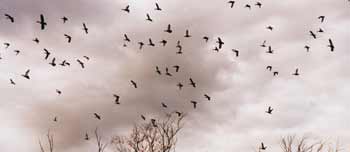
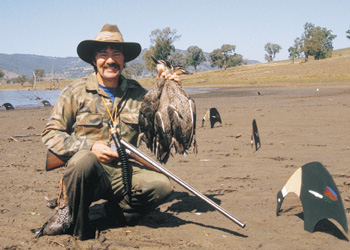
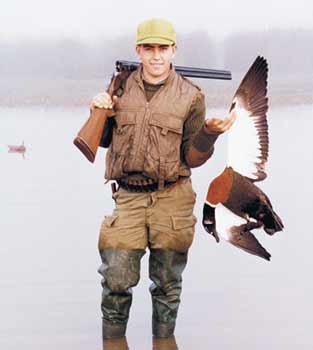
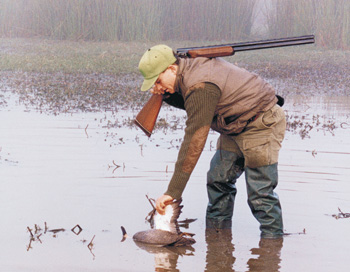

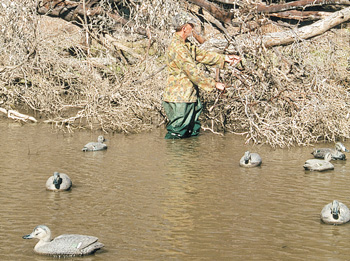
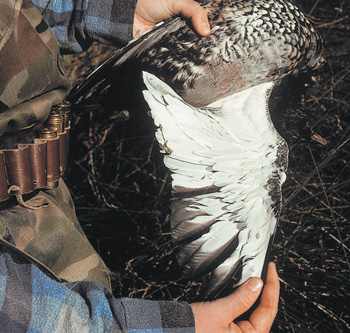
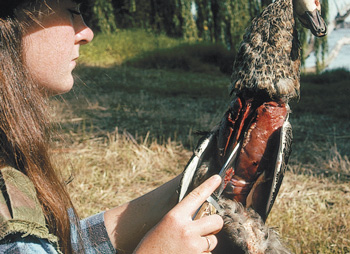 The hunting of wild ducks in this country is highly regulated so it’s only proper that we start with all of the paperwork associated with duck hunting.
The hunting of wild ducks in this country is highly regulated so it’s only proper that we start with all of the paperwork associated with duck hunting.
Obviously you will need a firearm licence, next comes the sitting of the WIT (Wildlife Identification Test). This is to ensure that you can correctly identify legal and, more importantly, protected species of ducks and other birdlife encountered on the wetlands while pursuing ducks. If you are unsure of how to go about sitting this test, approach your local branch of the SSAA for advice. Finally, you will need a game licence, which can be obtained from your state’s wildlife department.
Clothing
Choosing the right clothing is quite important. We are hunting ducks
during the hotter part of the year and diseases like encephalitis and
Ross River fever, to name a couple of the nastier ones, usually dictate
the wearing of long-sleeved shirts and long trousers. Dark coloured
clothing is essential - camouflage clothing is a good choice. A
wide-brimmed hat is excellent for protection from the sun and will hide
that shiny white face from any passing ducks if you happen to look
skywards at the wrong time.
The use of waders is common practice and they have come a long way since they were first introduced. Having said that, I must admit that care must be taken. I would only consider wearing them towards the end of the season when the water is cold and I am completely aware of the depth of the water I am wading through.
Firearm selection
With the loss of our best field guns (self-loaders and pump-actions) we
are not left with much to choose from. The under and over is now top
dog, but the old side-by-side still has a strong following with
traditionalists. The side-by-side is really the best choice for duck
hunting. The remaining options are the bolt action and the single-shot.
The choice of chokes has always been a bone of contention among shooters and many wrongly choose full-choke guns. While excellent for taking passing ducks out to 50 metres, there are not many duck hunters who can continually down ducks at that range. With more and more hunters turning to hunting over decoys, along with the introduction of steel shot, more open chokes are being used.
If you are starting out from scratch, approach a reputable firearm dealer and explain that you will be duck hunting - as the firearm needs to be suitable for steel shot. Luckily these days shotguns come with a multiple choice of chokes. It would be a good idea to take your gun to the local gun range and test pattern it to see which chokes best suit the use of steel shot, and how dense a pattern it throws. You will probably be surprised at the results; I know I was when I checked the steel shot pattern through my Beretta S686E.
Cartridge selection
When lead shot was the norm, everybody I knew reloaded their own
ammunition and it was part of the duck hunting experience. With the
introduction of steel shot, no-one reloads any more. When changing from
lead shot to steel shot and requiring more or less the same results, it
is recommended that you go up two sizes in steel to roughly equal lead.
Older hunters who have always used lead, up to the changeover, often
favoured No 4 shot and No 6 shot, but have now stepped up to No 2 shot
in steel to replace the No 4 shot in lead, and No 4 shot in steel to
replace No 6 shot in lead. The use of more open chokes is also
recommended.
The best way to find out what size steel shot suits your shotgun is to acquire different brands and shot size and take them to your gun club to have them checked on a pattern board. With my Beretta, I found Win XPERT 32-gram loads in No 4 steel through Improved Cylinder chokes proved to be the best, especially when used over decoys.
Constructing a blind
The construction of a blind is an important part of hunting ducks. They
are very alert birds and can quickly spot a trap, so a blind is really
a necessity. When building a blind, it needs to blend in as closely as
possible to the surrounding cover to make it as natural as possible. It
is not advisable to start chopping branches off nearby trees. During
the last couple of seasons I have been using a military camouflage net.
Mine is ten metres by three metres and can be draped over downed timber
or propped up with tent poles. These nets are just about perfect and
not too expensive to buy.
If you are a bit strapped for cash, and who isn’t from time to time, a suitable blind can be made from ground cover and dead branches. Just remember to make it large enough to be comfortable. Always disassemble it when you have finished, taking with you empty shells and pieces of loose rope or string as these tend to become lodged or tangled in animals when they come to drink.
Decoys
The number of decoys you will need depends mainly on where you are
shooting. If you are hunting over a small backwater, you will not need
many at all. You can probably get away with six decoys. You will need
more if you plan to hunt on a big expanse of water. We use about 50,
but I am not suggesting that you race out and buy a great heap of
decoys. The accumulation of decoys takes a number of years; buy half a
dozen or so each year. They are extremely well-made these days and if
looked after, will give many years of service.
When setting out your decoys don’t have them too far away from your blind and have it look as realistic as possible. Mix them up a little and have them facing in different directions. You are trying to get across that your decoy spread is a safe haven for any passing ducks. Leave plenty of room among your decoys for incoming ducks, otherwise they will pass over and pitch in further down.
Most of my decoying is done on calm water and I prefer to use the ‘V’ pattern. As ducks land into the wind I have the ‘V’ leading into my blind. Other patterns are the dotted ‘I’ and the fish hook pattern, but they take a bit of setting up. As you can only take five ducks, it may not be worth it.
Calling
It is often bandied about that if you can’t blow a duck call properly
then don’t blow it at all, for nothing alerts incoming ducks more than
a poor rendition. There are a number of calls that the budding duck
hunter needs to know and when used correctly will greatly enhance your
chances of a full bag. Different calls will work different ways in
certain areas and I usually use the long-range call on ducks that are a
bit of a distance away. This call is a series of loud quacks to start
with and tapering off at the finish. The number of quacks is around
seven, but I don’t think there is any hard and fast rule to the number.
If your long-distance call worked and the ducks have turned and are coming your way, use the chatter call when they are about 100 metres away. The chatter call is a series of low, quick-sounding quacks. If this call works, the ducks will cup their wings and begin descending. If they look as though they are hell-bent on landing among your decoys, make ready to take your shot. If they look a bit nervous, blow the feed call, which should calm them down. The Scotch duck call in the shaker model is perfect for giving out the feed-call. All you have to do is shake it and a series of very low, quick quacks associated with the feed-call flow naturally from it.
Quite often, and especially on opening morning, your spread of decoys may not be the first lot a mob of ducks have dropped into - they may be nervous. Usually if this is the case the ducks will pass overhead, just out of range, to suss things out. When they look as though they aren’t interested, they will often turn and come back over your spread again, this time they will be a bit lower. If you choose to do any calling at this time, it is advisable not to look up at the ducks as they will spot you every time.
Old hands will tell you there is no need to look up at this crucial moment, just listen to the whistle of the wing beats. A mob of ducks may do this a few times, each time getting lower and lower, then if they are satisfied that all is well, they will cup their wings, lower their landing gear and come cruising in. If, however, they smell a rat and start flying off, you can try the ‘come back’ call which is a series of high, slow-blown quacks.
Some of the better brands of duck calls come with instructions on how to blow the different types of calls associated with successful duck calling. It is advisable to study the method of calling. It is then a case of practise, practise and more practise until you have it right.
Tricks for improving your bag
You really could write a book on this subject but I will mention some
of the more popular tricks:
- Ducks are very sharp-eyed and very greedy, so put a bit of movement in your decoy spread to arrest the attention of passing ducks. A teaser board (or bottle) is well worth the trouble of setting up. The floating board is stationed above a stake or peg which has an eyelet attached to it. This allows a piece of cord to pass from the bottom of the teaser, through the peg and back to the blind. When you see the ducks coming towards your decoys, pull on the cord, this in turn will make the teaser board bob about, putting heaps of ripples among your decoys. There is nothing a passing duck likes to see more than a mob of ducks happily feeding away.
- If you have a mob of ducks dropping into your decoys from in front of your blind, wait till the very last moment, then stand up with your gun coming to your shoulder. Your sudden movement will be undoubtedly spotted by the incoming ducks and they will bank sharply, with wings flared, thus presenting you with the decoyer’s preferred shot.
- When shooting at passing ducks, always remember to give them a lot of lead and shoot at the back of the mob. This will allow you to follow through onto another duck if the first one has folded.
Ethics
Ethics is conducting yourself in a sportsman-like manner and treating
other hunters with respect. Such as:
- Don’t squabble over ducks. Sometimes, especially when shooting on big swamps, more than one hunter will fire at a duck. There is nothing more childish than two grown men fighting over a dead duck. The simple solution is to walk away and go back to hunting.
- Always give other hunters enough room to hunt, especially if they are using decoys.
- If it seems another person is hunting successfully and you are not firing a shot, break your gun and ask if you can join him/her. Most duck hunters enjoy the company of other like-minded hunters.
- The only time a duck should be shot on the water is when a wounded duck has to be humanely dispatched. The shot should only be taken when it is safe to do so.
Duck hunting is a challenging pastime and once you have experienced it, it will get in your blood and you will never tire of it. The beautiful smell of the wetlands, the sound of the whistling wings of passing ducks - to a duck hunter, that is the elixir of life.
Captions
Image 1: When a big mob of ducks passes within
gun range, remember to select a bird and fire, do not mob-shoot.
Image 2: Silhouettes are gaining in popularity
with duck hunters these days and they work just as well as decoys.
Image 3: Mountain ducks decoy well and it is
simply exhilarating to watch them drop out of the sky to land among
your decoys.
Image 4: This hunter used the high stand of
Cumbungi in the background as a hide and was successful in taking this
black duck.
Image 5: Leather loops attached to a belt are a
good way to carry ducks already taken.
Image 6: A good blind is a necessity when
hunting over decoys. It is imperative that the concealed hunters are
not spotted by ducks pitching in.
Image 7: The easiest way for the new hunter to
get to know the bird he is to hunt legally is to learn the colour
markings, they are all different. Do you know what duck this is?
Image 8: Breasting a duck is quick and easy, but
remember to wait until you get home before you do it.
